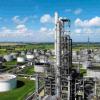Hi.
I am trying to do a simulation in Hysys to establish RVP in accordance with ASTM D 323 - 99a. I use the following procedure:
I have a crude composition with no water at 0 °C and 1.013 bara. Volume flow 1 m3/h.
I create a sidestream with 78% N2 and 22% O2 (air) at 37.8 °C at 1.013 bara. Volume flow 4 m3/h.
The two streams are mixed and heated to 37.8 °C.
The pressure is varied until the volume flow is 5 m3/h. Temperature is fixed at 37.8 °C.
In my opinion the corresponding pressure should give the RVP pressure, but it is not in accordance with the value given by Hysys?

 FB
FB











